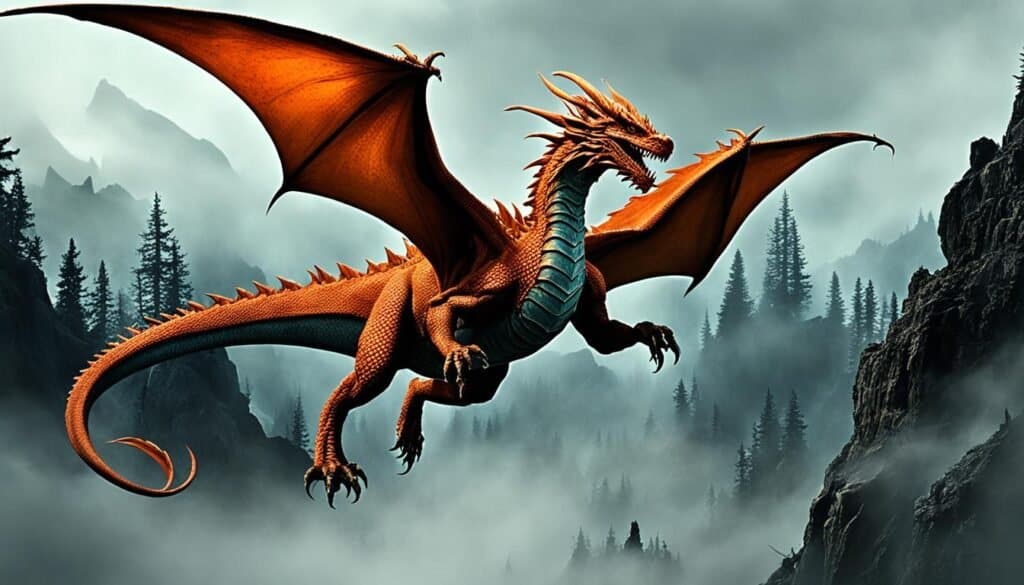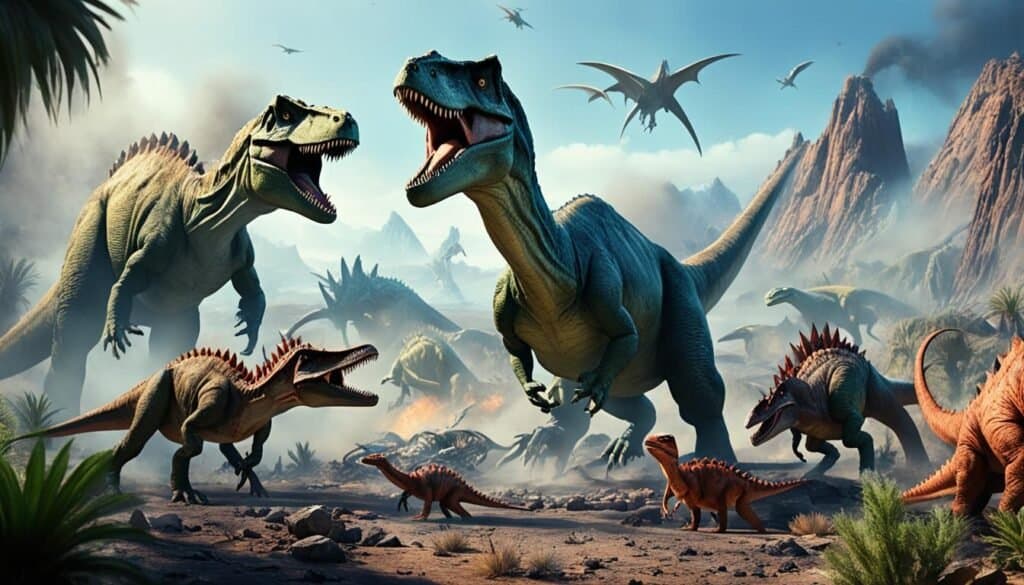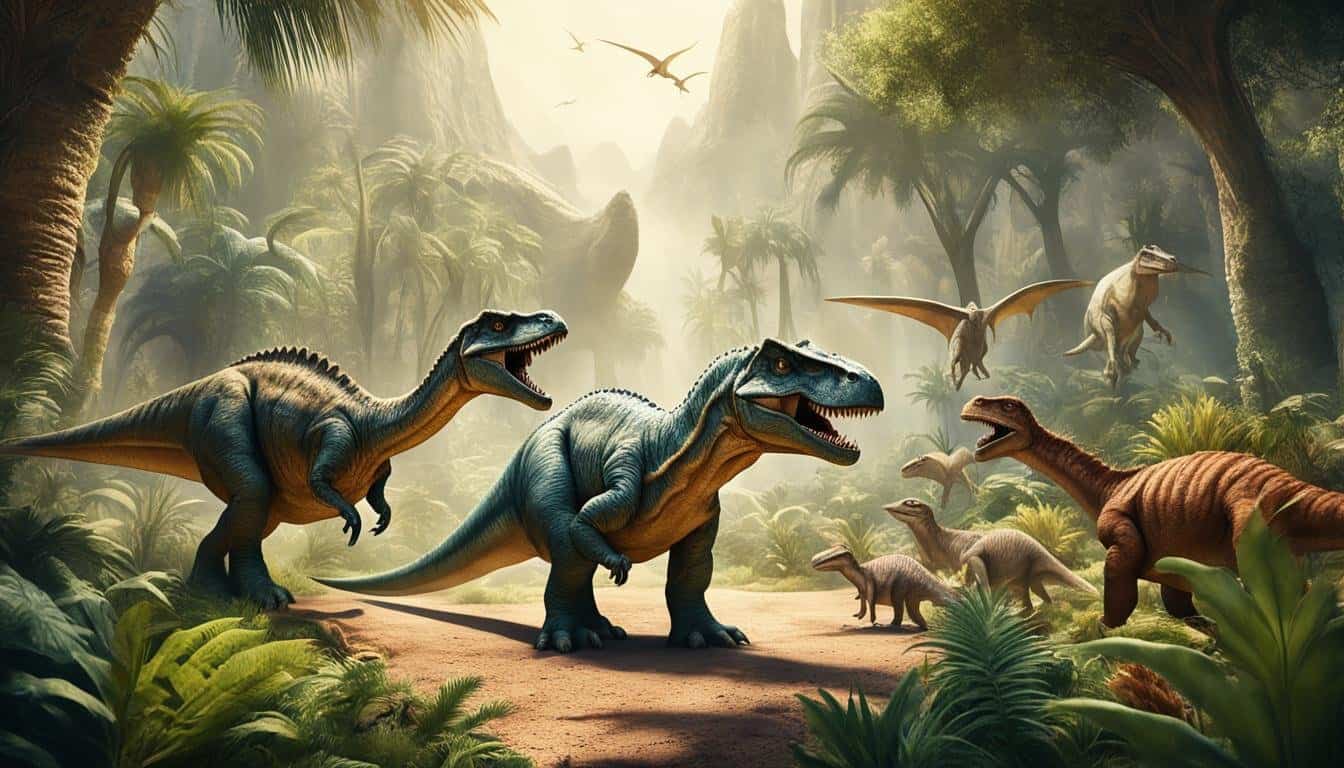Have you ever thought about the huge creatures mentioned in old stories? Are they just myths, or could they be real dinosaurs? Looking into the Bible, we find stories of big creatures like behemoth and leviathan. These stories might help us link faith with the real existence of these amazing animals.
We’re going to look closer at how these creatures are described in the Bible. We’ll see if these stories match what we know about dinosaurs. This journey will show us how ancient stories, the Bible, and dinosaurs are connected. Are these stories just for show, or do they mean something deeper about dinosaurs and the Bible?
Let’s start this exciting adventure together.
Key Takeaways
- Dinosaurs may be hinted at in biblical stories like behemoth and leviathan.
- Old stories often talk about big animals, leading to interesting ideas.
- Looking into these stories can deepen our understanding of dinosaurs.
- This could change how we see faith and paleontology together.
- How we interpret these creatures can differ across cultures and times.
The Concept of Dinosaurs in Ancient Texts
Ancient texts give us a glimpse into the lives of huge, powerful creatures that some think were dinosaurs. The Bible and other old writings talk about these beings in ways that catch our attention. They describe them in a way that matches what we know about dinosaurs today.
These descriptions from the Bible and other texts paint a vivid picture. They show us a link between old myths and modern science. This link makes us think about how ancient people saw these huge animals.
Looking at these descriptions, we see how people in the past saw these massive beings. Their views changed as we learned more about the past. This shows us the importance of looking closely at old texts. It helps us understand how humans have seen and thought about big creatures over time.
Understanding Behemoth: The Mighty Creature
We dive into the fascinating world of behemoth, focusing on Job 40:15-24 (KJV). This biblical text paints a picture of a massive creature. It’s like a dinosaur, but with a twist. The scripture’s vivid details let us peek into its possible reality.
Job 40:15-24 (KJV) and Its Interpretation
The verses in Job give us a glimpse into behemoth’s world. It’s a creature of huge size, with a tail like a cedar tree. This image makes us think of ancient giants, similar to dinosaurs. Its bones are as strong as brass, showing its incredible power.
The Physical Attributes of Behemoth
Let’s look closer at behemoth’s physical traits. The text describes a creature of immense strength and size. When we read Job 40:15-24 (KJV), we see parallels with dinosaurs. Here’s a table comparing behemoth with dinosaurs:
| Attribute | Behemoth | Dinosaur-like Creature |
|---|---|---|
| Size | Massive, compared to a cedar tree | Vast, enormous sizes like Argentinosaurus |
| Strength | Described as having bones like brass | Known for powerful build and strength |
| Habitat | Primarily water-dwelling or near rivers | Some species were aquatic or lived near water |
| Physical Appearance | Large, imposing physical presence | Distinctive features, including long necks and tails |
This comparison sheds light on the possible truth behind behemoth. It opens up discussions on whether such creatures existed. We encourage readers to explore more about these intriguing connections, like biblical interpretations and ancient texts.

Leviathan: The Sea Monster
In Job 41 (KJV), we meet leviathan: the sea monster, full of mystery and fear. This chapter vividly describes a fearsome sea creature. It inspires awe and fear with its powerful features. The imagery in this text is key to understanding its cultural importance. Leviathan symbolizes immense power in biblical stories.
Job 41 (KJV) and the Imagery of Leviathan
The description of leviathan in Job 41 (KJV) shows a creature unmatched in strength. It talks about its scales, like impenetrable armor, showing it’s almost invincible. The text also mentions its fiery breath and the fear it brings to those who get close. These details make us think about whether leviathan is like ancient reptiles, known for their fierceness and rule in their worlds.
Comparing Leviathan to Ancient Reptiles
This look at leviathan invites us to compare it to ancient reptiles, especially huge sea creatures from long ago. We see similarities between this biblical figure and dinosaurs. Below, we highlight some key features that link leviathan to ancient reptiles, like size, where it lived, and what makes it scary.
| Characteristic | Leviathan | Ancient Reptiles |
|---|---|---|
| Size | Gigantic | Varies (some were immense) |
| Habitat | Sea | Marine and terrestrial |
| Defensive Features | Impenetrable scales | Thick hides, tough armor |
| Methods of Attack | Fiery breath | Powerful jaws, claws |
| Cultural Impact | Symbol of chaos and power | Representations in art and mythology |
Leviathan in the biblical text is more than just a sea creature. By comparing it to ancient reptiles, we see its role in human stories and beliefs. If you’re interested in how this affects biblical symbolism, check out this link. The talk on leviathan shows how ancient texts share deep truths about powerful and mysterious beings.
Dragons in the Bible: Myth or Reality?
Looking into the biblical depiction of dragons makes us think about their symbolism and if they could be real. The stories in scripture mix myth with history, making us wonder: are dragons myths or real? Isaiah 27:1 (KJV) gives us a great chance to see the deeper meaning behind dragons.
Isaiah 27:1 (KJV) and the Symbolism of Dragons
This verse uses dragons and leviathans as symbols of chaos and evil. The symbolism of dragons goes beyond just stories. It shows us how these creatures might stand for the big fights we face in life and history.
Dragons as Reflections of Ancient Creatures
Looking into our ancient creature reflections, we see how dragons might be based on real animals. Old stories might be about huge reptiles. Large sea reptiles or dinosaurs could have inspired the myths we see in stories. This idea makes us think that what we see as myths might have come from real animals.

Looking at Isaiah 27:1 and dragons in general, we see they can be seen in two ways. As we learn more, we might find that myths and reality are closer than we think. For more on this, check out different views that show how myths and history connect.
Explore more on biblical interpretationsand their connections to reality
The Creation of Dinosaurs
In the early chapters of the Bible, we find deep insights into life’s diversity. Genesis 1:21 (KJV) tells us about God creating “great sea creatures.” This could mean a wide range of life forms, including dinosaurs. It shows God’s vast creation and the variety in nature.
Genesis 1:21 (KJV) and Divine Creation
Genesis 1:21 (KJV) highlights God’s intention in creating life on earth and in the seas. The phrase “great sea creatures” might include marine and land reptiles, like dinosaurs. Fossils show the complexity and size of these creatures, showing they came from God’s imagination.
What “Great Sea Creatures” Could Indicate
Looking into “great sea creatures” makes us think about dinosaurs and God’s creation. Scholars believe these creatures show the vastness and richness of God’s work. They help us see the detailed life God created, adding to our view of ancient ecosystems.

Reflecting on God’s creation helps us see the diversity in life. Dinosaurs and sea creatures leave a lasting impact on us. Studying history and resources like this deepens our understanding of nature and ancient texts.
| Aspect | Dinosaurs | Great Sea Creatures |
|---|---|---|
| Habitat | Land | Oceans |
| Size | Various, including massive | Varied, some gigantic |
| Fossil Records | Abundant | Extensive |
| Era | Mesozic Era | Spans multiple eras |
Dinosaurs in the Context of Extinction
Thinking about dinosaurs and their extinction makes us ponder Ecclesiastes 3:1 (KJV). It says, “To everything there is a season, and a time to every purpose under the heaven.” This verse teaches us about life’s cycles. It makes us think about the creatures’ seasons and the eras of ancient creatures. We wonder how this relates to the dinosaurs’ extinction.
Understanding Ecclesiastes 3:1 (KJV)
This verse tells us that everything has its own time. Dinosaurs lived during a certain time with unique weather and ecosystems. Their existence matches the idea in Ecclesiastes, showing that species can rise and fall like seasons change. This idea helps us understand why dinosaurs came and went.
Implications for Dinosaurs and Their Era
Ecclesiastes 3:1 (KJV) helps us see how fragile life is. Dinosaurs faced changes in their world and competition from others. They eventually disappeared. This shows God’s plan for all creations in ancient creatures’ eras. Dinosaurs teach us about the Earth’s many changes, leading to the diversity we see today.

| Aspect | Dinosaurs | Time Period | Ecclesiastes Connection |
|---|---|---|---|
| Era | Mesozoic Era | Approximately 252 to 66 million years ago | Time to thrive |
| Extinction Event | Cretaceous-Paleogene Extinction | About 66 million years ago | End of a season |
| Environmental Changes | Asteroid impact, volcanic activity | Transition period | Natural cyclical changes |
| Lessons Learned | Adaptation and evolution | Life’s temporal nature | Purpose and seasons |
The Flood and Extinction of Dinosaurs
Looking into the flood and extinction of dinosaurs, we find clues in ancient texts. Genesis 7:21-23 (KJV) tells us about the great flood. This flood was a big change on Earth, making us wonder about its effect on dinosaurs.
Genesis 7:21-23 (KJV) and the Great Flood
Genesis 7:21-23 (KJV) paints a picture of a time when “all flesh died that moved upon the earth.” This shows a huge event that could destroy a lot. The flood changed the land and led to the death of many living things. This makes us think about if dinosaurs could have gone extinct during this time.
Dinosaurs’ Potential Fate During the Flood
The flood could have led to the extinction of dinosaurs. With the waters rising, their homes were destroyed. Some ideas say this event caused the mass extinction we see in fossils. By looking at the geological evidence, we can learn more about what happened to dinosaurs during this time.
Were Dinosaurs Mentioned in the Biblical Account of Noah’s Ark?
There is no direct mention of dinosaurs in the biblical account of Noah’s Ark, but some believe creatures like them could have existed before the flood. One of the key lessons learned from noah’s ark is the importance of faith and obedience in times of uncertainty and impending disaster.
God’s Power Over Creation
Looking at the natural world, we see God’s power clearly. From tiny insects to huge dinosaurs, everything shows God’s skill. Psalms 104:24 (KJV) helps us see the beauty and wonder of life. It shows us our place in this amazing world.
Psalms 104:24 (KJV) and the Wonders of Creation
This verse makes us think about the beauty and complexity of creation. It shows us how much life varies, from today’s animals to dinosaurs that lived long ago. We see that every living thing, big or small, has a part in the world’s beauty.
By looking at creation, we learn more about our world and its past. We see how all living things work together. This shows us God’s creativity and how everything fits into His plan. It tells us that even dinosaurs were part of God’s story.
Understanding creation’s wonders helps us see our place in the world. It shows us how everything, from the biggest dinosaur to the smallest bug, has a purpose. This reminds us that our Creator made everything with a special role in mind.
Affiliate Disclosure: "As an Amazon Associate I earn from qualifying purchases made from links in this post. We are a participant in the Amazon Services LLC Associates Program, an affiliate advertising program designed to provide a means for us to earn fees by linking to Amazon.com."

